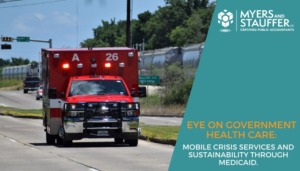 In a series of posts, Myers and Stauffer will highlight parts of the American Rescue Plan Act of 2021[1] that can have tremendous impact on delivery and financing of services by state health and human services programs.
In a series of posts, Myers and Stauffer will highlight parts of the American Rescue Plan Act of 2021[1] that can have tremendous impact on delivery and financing of services by state health and human services programs.
May is Mental Health Awareness Month and today’s focus from the American Rescue Plan Act (ARPA) of 2021[1] is on mobile crisis intervention. The ARPA provides a great opportunity for states to start a new mobile crisis services program with enhanced funding, or to explore new options for providing crisis intervention services. The APRA provides an 85 percent federal match for the first three years that a state covers mobile crisis intervention services for mental health or substance use disorders as well as $15 million for state planning grants.
Mental health and SUD crisis services are key components to behavioral health programs and typically occur in several different forms including 24-hour crisis hotlines, walk-in services, and mobile crisis teams. The Substance Abuse and Mental Health Services Administration (SAMHSA) cites inadequate crisis care as a reason for costs to escalate due to an overdependence on restrictive, longer-term hospital stays, hospital readmissions, overuse of law enforcement, and human tragedies that result from a lack of access to care[2]. The ARPA funding specifically targets mobile crisis teams who differ from other forms of crisis response by providing intervention on location wherever the crisis is occurring, such as in schools, at a residence, or on the street. Mobile crisis providers typically have some partnership with law enforcement or use some other mechanism to receive a crisis response notifications from 911 (or the non-emergency) dispatch centers.
Mobile crisis systems operating within communities may be different from each other depending upon how emergency calls are handled and how resources are dispatched. One model of mobile crisis includes a partnership with emergency medical services (EMS) agencies rather than law enforcement. Often referred to as paramedicine mobile crisis services, this model typically occurs in communities where EMS deploys to any emergency call where there is likelihood of needing medical or behavioral health intervention.
Partnering with EMS rather than law enforcement has some distinct advantages. EMS employees are health care providers who are already accustomed to billing for reimbursable services. EMS agencies have qualified medical professionals who can conduct a physical health care assessment and help to determine if the person needs to be treated in the emergency department or if they can be diverted to a community based program. For rural EMS agencies which may experience less funding with greater periods of downtime than their urban counterparts, providing mobile crisis services can help to sustain their programs by increasing their ability to bill for what otherwise might be non-billable time. Leveraging existing first responder programs and telehealth are best practices highlighted by SAMHSA for crisis services in rural areas.
SAMHSA has resources available3 if you are interested in learning more about mobile crisis intervention. You can also contact our professionals for more information on how to implement and leverage Medicaid or other health and human services programs.
Contact the Contributors:
| Catherine Sreckovich Director csreckovich@mslc.com |
Julia Kotchevar, MA Health Care Senior Manager jkotchevar@mslc.com |
[1] https://www.congress.gov/bill/117th-congress/house-bill/1319/text
[2] https://www.samhsa.gov/sites/default/files/national-guidelines-for-behavioral-health-crisis-care-02242020.pdf



